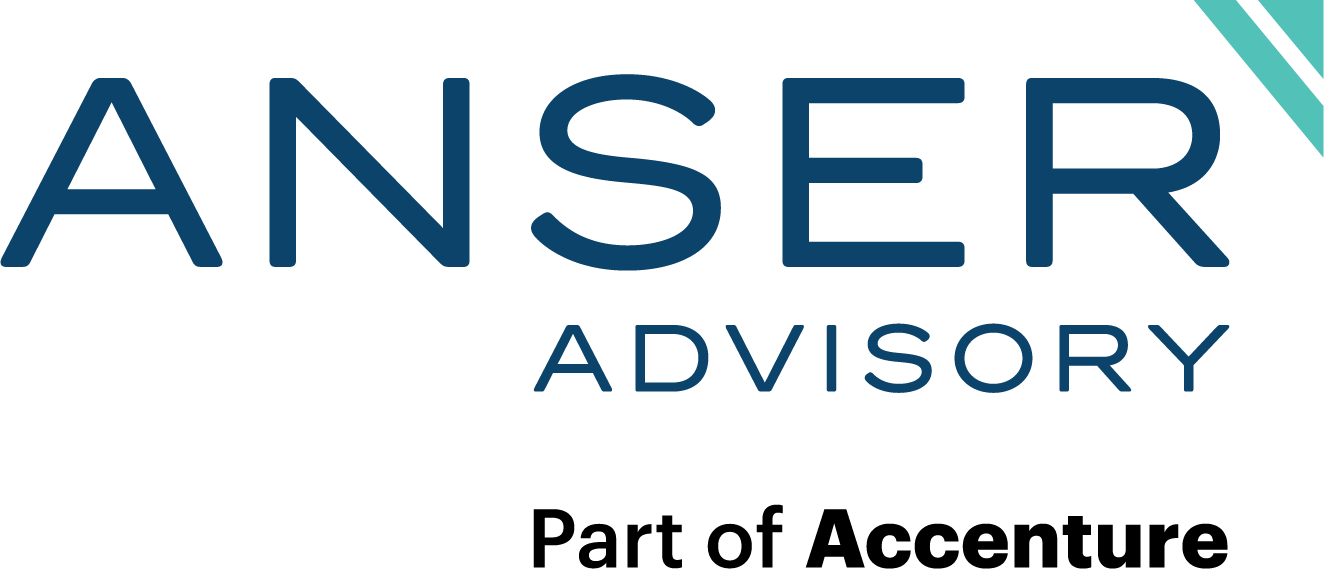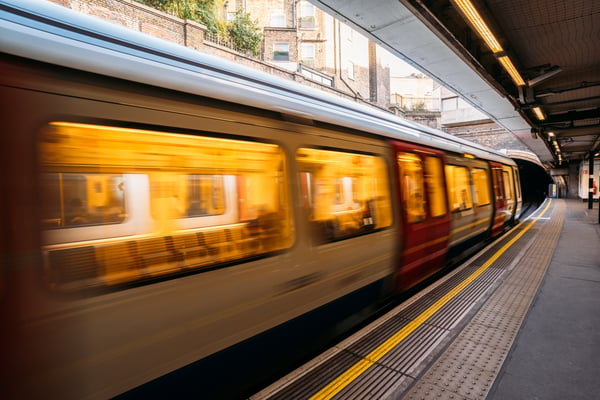A Seamless Journey and Enticing Destinations
The opening of Metro’s Regional Connector and three new downtown LA stations on June 16th proves there is such a thing as a free ride! This project will make some commutes much faster and is a massive win for public transit in LA and Metro is celebrating with a weekend of free rides!
This project is a long time in the making and will provide riders a seamless journey from Azusa to Long Beach, from East Los Angeles to Santa Monica, and through the downtown LA core. The project includes three new underground stations and extends from the L Line (Gold) in Little Tokyo and Arts District communities to the A (Blue) and E (Expo) Lines at 7th Street/Metro Center Station.
This project makes it easier to ride across LA County as passengers can travel between Azusa and Long Beach, and between East Los Angeles and Santa Monica, without transferring lines. It will improve connections, bringing together the current Metro L (Gold), A (Blue), E (Expo), B (Red), and D (Purple) Lines at the 7th Street/Metro Center Station, and increase opportunities for jobs, education, and essential services. The project will also combine the A, E, and L Lines into two rail lines — the new A and E Lines. For more information on rail service changes and opening day events, visit metro.net/moreDTLA.
The Regional Connector and three new downtown L.A. stations are to open Friday, June 16, with a weekend of free rides! | The Source (metro.net)
Metro’s Mission to Connect Communities and Provide Access to LA’s Rich Historic Areas
It is anticipated that with improved access to LA’s diverse cultural landscape, the community will enjoy greater work, education, and entertainment opportunities. LA Metro expects the updated system to bring in up to 17,000 additional daily trips. Taking cars off the road will improve congestion and reduce emissions outputs, combatting the worst aspects of LA’s single-passenger vehicle habit.
Unfortunately, Angelenos have historically avoided transit because of unreliable rides, long wait times, and multiple transfers. Many citizens opt for single-passenger vehicle trips over transit, and the downtown traffic creates congestion and environmental impacts that threaten long-term sustainability. LA Metro believes more efficient, equitable mass transit could revamp how citizens navigate LA’s sprawling landscape. By adding 1.9 miles of additional track to its underground subway, the Regional Connector is designed to shave 20-30 minutes off cross-county trips and minimize frustrating transfers.
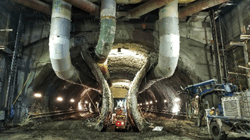 Now that the Regional Connector transit project is near completion, it will provide more Angelenos with access to the business, education, and entertainment hubs that help LA thrive. To make all this happen, it has taken many hours, days, months, and years of planning, procurement, design, program management, and construction management. And tunneling! Lots of tunneling to create the light rail’s new home beneath the Los Angeles downtown area.
Now that the Regional Connector transit project is near completion, it will provide more Angelenos with access to the business, education, and entertainment hubs that help LA thrive. To make all this happen, it has taken many hours, days, months, and years of planning, procurement, design, program management, and construction management. And tunneling! Lots of tunneling to create the light rail’s new home beneath the Los Angeles downtown area.
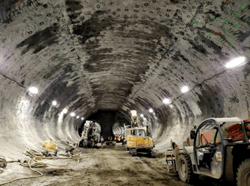 Digging Up Convenient, Equitable Mobility
Digging Up Convenient, Equitable Mobility
Tunnel excavations uncovered everything from an old aqueduct to whale bones. Near Walt Disney Hall and the Colburn School, engineers had to build a track without making vibrations or sound that would mar the experience for concertgoers. At Broadway, engineers had to construct the station so that it could sustain the weight of a high-rise building overhead. And Bunker Hill provided a unique challenge: The Grand Avenue station had to be built more than 100 feet below ground, reachable only by a bank of six elevators and stairs.
Providing a one-seat ride across LA that expands access for residents would require multiple underground construction elements to add additional rail and three stations: Little Tokyo/Arts District, Historic Broadway, and Grand Av Arts/Bunker Hill. To construct a cavern and stations without disturbing existing building foundations and utilities, LA Metro turned to experts on the construction management team led by Arcadis and including Anser (Arcadis/Anser Team) to act as engineering construction managers. The team performed various underground construction projects depending on the local conditions.
Tunneling was done to connect new and existing stations. At Little Tokyo/Arts District, a cut and cover approach built a bridge to protect utilities and allow the team to dig space for the new station beneath them. One of the more complex challenges was near the Historic Broadway station, where sequential excavation method mining (SEM) was used to complete a mined crossover tunnel in 2019. The Arcadis/Anser Team chose SEM because it allows for the use of conventional equipment and materials without causing surface settlement issues, and it is well-suited for tunneling in areas prone to earthquakes.
Anser Advisory's Path to Completion
It is hard to believe that my involvement with the Metro Regional Connector began in 2010 when I led the Arcadis proposal prepositioning efforts prior to joining DHS, now Anser Advisory. It has indeed been a journey from procurement to completion. I am proud of my team and the efforts that have contributed to the success of this project. DHS (legacy Anser) was a crucial part of the win strategy. DHS founder, Sudhir Damle was the proposed Resident Engineer and was a key interview participant. DHS & Sudhir Damle's participation at the interview were key factors for selection.
- Craig Halvorson
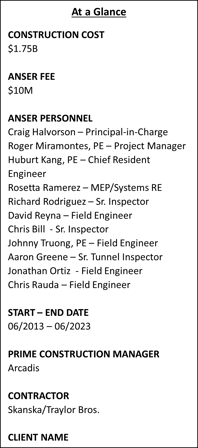 Level of Effort/Quality of Service
Level of Effort/Quality of Service
While Arcadis serves as the prime construction manager, Anser has provided the project-wide Chief Resident Engineer and the Systems/MEP Resident Engineer along with several field engineers and inspectors. These individuals perform various tasks including schedule analysis, field oversight, observations of work progress, change requests analysis, monthly reporting, development of risk registers, and issue binders. Additionally, Anser provides field inspection for extensive excavations and shoring, utility relocations, station foundation construction, and systems such as mechanical and electrical.
Metro Regional Connector is a mega-project with a long duration, so we were intentional in our approach to provide and maintain local experts that understand the culture of Metro and the community. Anser staff has remained on the project for the past four years, growing in responsibility and capabilities. This has been accomplished through ongoing workshops, training on lessons learned, and investment of senior management to engage staff regularly in regard to their purpose and responsibilities on the project.
Challenges/Lessons Learned
With any significant mega-project, daily challenges must be addressed and resolved. This is accentuated when working through aging infrastructure. Recognizing unforeseen utilities is a common challenge. Anser’s planning, action, and solutions applied smoothed the path to success. One example is discussed in the following narrative.
An Advanced Utility Contract (AUC) was designed to relocate the street utilities before the commencement of the main Design-Build contract. The AUC contractor encountered numerous differing site conditions that caused significant delays and cost overruns. The AUC contractor was eventually terminated for convenience, and the remaining utilities were relocated by the main Design-Build contract. The primary lesson learned is that the Contract Drawings should not be labeled an underground line “protect in place” unless sufficient potholing or excavations can be performed to determine that the actual condition of the line labeled “project in place” are actual. Or to provide investigative provisions for the Design-Builder to determine relocation.
Project Success
Metro’s Regional Connector success is built on quality and the equity it will provide its riders. Anser takes pride in our work on the project and has gone to great lengths to hold the Design-Build Contractor (Contractor) accountable for their performance. Creating a partnership with the Contractor has developed into a world-class team providing services to ensure a quality product for Metro and its customers. We listen to and partner with Metro, the operations and maintenance staff, and leaders of concurrent and/or adjacent projects to ensure all lessons learned are not forgotten but applied. We observe and report effectively to keep the Contractor compliant with the Contract, taking no shortcuts. There are many ways to build, but only one way of doing it right the first time.
Key Staff Highlights
Anser’s Huburt Kang serves as project-wide Chief Resident Engineer. Huburt oversees the construction management staff to perform all activities and maintains close relations with the Contractor. As Chief RE, Huburt delegates work as needed with the construction management staff, which includes quality assurance inspectors, Assistant Resident Engineers, Resident Engineers, Field Engineers, and administration. His role includes project-wide oversight of all three underground stations and the guideway from the Pico Aliso/Union Station to 7/Metro. The station and guideway scope of work includes ventilation systems (emergency and HVAC), electrical, communications, trackwork including three unique track constructions, station fire life and safety system, architectural features, and even station artwork! He is responsible for managing portions of the change management items by resolving and mitigating issues proactively to provide Metro with the fairest and most reasonable cost.
Huburt’s understanding of construction has successfully resolved change management issues. Huburt has negotiated an average of $0.30 on the dollar (30% reduction) to what the Contractor has proposed. Huburt has also successfully coordinated with 3rd party agencies such as Los Angeles Department of Transportation (LADOT), Los Angeles Department of Water and Power (LADWP), the City of Los Angeles, the community, and more.
Rosetta Ramerez is the project-wide mechanical, electrical, and plumbing (MEP) and rail systems Resident Engineer. Three underground stations have 250 hp emergency ventilation systems and high voltage traction power substations that energize the train by using 750 DC voltage. Metro’s Regional Connector is unique because it goes underground and uses overhead contact rail (OCR). The train control system includes CAB signaling, train-to-wayside communication (TWC), track circuits, switch machines, TWC loops, and two reverse-running applications. The communication system consists of intrusion detection and CCTVs using fiber optics for the main backbone. There is a SCADA system for monitoring and controlling systems from Central Control. Her role includes coordinating MEP for all three underground stations.
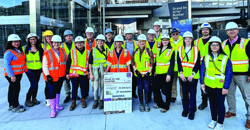 In late 2021, Rosetta had the responsibility of coordinating the bus bridges in order to interface with the new systems. This included the cutover of the OCR, train control system, communication system, and emergency fans. One complication is that the fire detection in the older Blue Line segment has the 48 cable and the new Regional Connector segment is using the new fiber optic technology of 144 of fiber for the backbone, providing a digital infrastructure. Rosetta was responsible for reviewing the Contractor’s testing and
In late 2021, Rosetta had the responsibility of coordinating the bus bridges in order to interface with the new systems. This included the cutover of the OCR, train control system, communication system, and emergency fans. One complication is that the fire detection in the older Blue Line segment has the 48 cable and the new Regional Connector segment is using the new fiber optic technology of 144 of fiber for the backbone, providing a digital infrastructure. Rosetta was responsible for reviewing the Contractor’s testing and 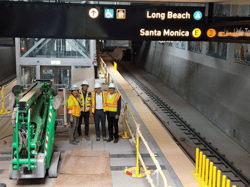 local field testing procedures and systems integration. The bus bridges consisted of a 56-hour shut down to remove the old train control system and install the new one to allow time for testing and troubleshooting. It took a total of 10 bus bridge weekends to complete this task. Through Rosetta’s leadership, this effort avoided impacts to regular revenue operations.
local field testing procedures and systems integration. The bus bridges consisted of a 56-hour shut down to remove the old train control system and install the new one to allow time for testing and troubleshooting. It took a total of 10 bus bridge weekends to complete this task. Through Rosetta’s leadership, this effort avoided impacts to regular revenue operations.
Seamless Journey with Connected Destinations
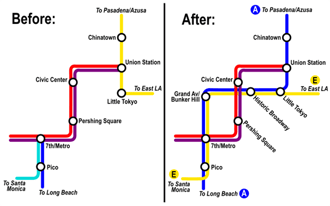 How does this journey effect the daily lives of Angelenos? Although Metro’s Regional Connector is not a new line (although there are new stations), it is an extensive reconfiguration of existing lines. The diagram to the right illustrates the changes.
How does this journey effect the daily lives of Angelenos? Although Metro’s Regional Connector is not a new line (although there are new stations), it is an extensive reconfiguration of existing lines. The diagram to the right illustrates the changes.
Until now, the Blue and Expo Lines have come up from the south and terminated at the 7th/Metro station. The Gold Line cut across the northeastern corner of Downtown, stopping at Union Station and Little Tokyo. If you wanted to transfer between these lines, you had to transfer to the Red/Purple Lines and ride those across Downtown. This process can add up to 20 minutes to travel time.
With the nearing completion of the Regional Connector, the Blue, Expo, and Gold Lines have been combined into two lines: the A LINE will go directly between Long Beach and Azusa, and the E LINE will go directly between Santa Monica and East LA. Not only is Downtown more accessible but trips across Downtown that previously required two transfers can now be done with only one or even no transfers.
If you live or work along the Blue, Expo, or Gold (now the A & E) Lines, this represents a massive opening up of the city to you. If you're a transit user in Los Angeles, this could be huge for you. It means fewer transfers, less waiting, faster service across town for tens of thousands of current riders, and untold future riders. Trips you wouldn't even consider making by transit suddenly become feasible, and long trips that people endure now will be much faster.
Where do we go from Here?
It’s been an exciting journey for members of Anser, and a long time coming for Metro and Los Angeles, but having this tunnel stitch together the far-flung reaches of our transit system should prove worth the wait. The goal of “connecting communities” is attainable; for many of LA’s transit riders, the city will become easier to navigate, and local businesses will also see the benefits of increased ridership and ease of access. Anser is proud to have been a part of this historical and - for some traveling Angelenos - life-changing project.
About Anser Advisory
Anser Advisory is a US-focused capital infrastructure consulting firm. We are currently ranked #14 in ENR’s 2022 Top 50 Program Management Firms, 2nd on the Zweig AE Fastest Growing Hot List for 2022, a certified Great Places to Work organization and one of the founding partners of the Equity in Infrastructure Partnership (EIP).
Anser Advisory directly supports a diverse client base by deploying deep subject matter expertise across acquisition and procurement management, program management and controls, project and agency construction management, security consulting, enterprise technology management and training solutions.
ALASKA | CALIFORNIA | COLORADO | FLORIDA | ILLINOIS | MARYLAND | MASSACHUSETTS | NEW YORK | NEW JERSEY | NORTH CAROLINA | OHIO | PENNSYLVANIA | TEXAS | VIRGINIA
